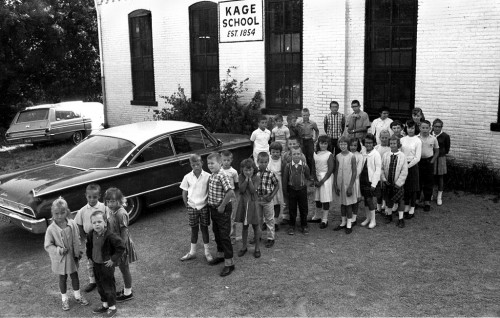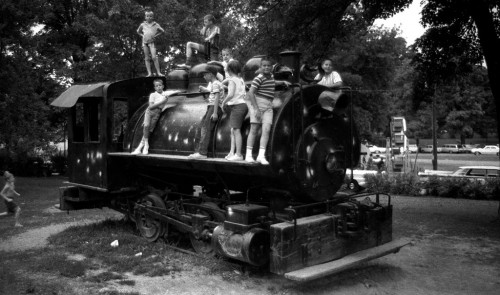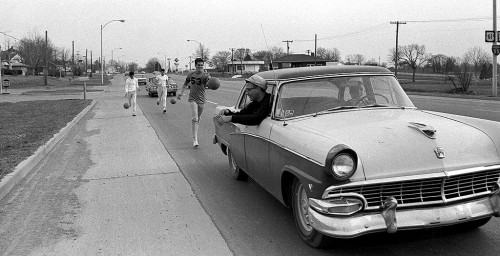September, 1965, I heard that The Beatles’ movie Help! was going to play at the Esquire. It had gotten all kinds of buzz everywhere else it played, so I decided to do something unusual to cover it.
 I was going to use infrared film and infrared flashbulbs to photograph the audience’s reactions without drawing attention to myself. If you were looking directly at the flashbulb when it went off, you might see a dull glow of the filament, but it was otherwise invisible.
I was going to use infrared film and infrared flashbulbs to photograph the audience’s reactions without drawing attention to myself. If you were looking directly at the flashbulb when it went off, you might see a dull glow of the filament, but it was otherwise invisible.
Infrared light makes some colors and skin tones look strange and the years have not been kind to the negatives, but it’s still fun to look back at a more innocent age.
The goal was to be unobtrusive
The Missourian normally wanted full names, addresses and the names of parents, but the editor understood that I needed to be unobtrusive and waived the rule.
Because of that, I only know (or can guess) at a few of the audience members.
The girl on the left, for example, is Marty Perry Riley, who would become my sister-in-law four years later.
A few Central High students showed up
 The person second from the left is Pat Sommers; Phil Vinyard is next to him on the right. I think the popcorn muncher on the right is Jim Stone, but he denies it. He thinks the fellow on the far left is Bill Wilson; Terry Hopkins guessed Jim Wilson. I’ll let someone else make the call.
The person second from the left is Pat Sommers; Phil Vinyard is next to him on the right. I think the popcorn muncher on the right is Jim Stone, but he denies it. He thinks the fellow on the far left is Bill Wilson; Terry Hopkins guessed Jim Wilson. I’ll let someone else make the call.
 I’m sure the girl on the right is Pat Johnson. We not only went to high school together, but we spent eight years as classmates at Trinity Lutheran School.
I’m sure the girl on the right is Pat Johnson. We not only went to high school together, but we spent eight years as classmates at Trinity Lutheran School.
Everyone else is a mystery to me. Feel free to comment and I’ll update the information.
Denny O’Neil wrote the story
Denny O’Neil was the reporter assigned to do the story to accompany my pictures. He went on to gain fame in the comic book business after he left The Missourian.
His best-known works include Green Lantern/Green Arrow and Batman with Neal Adams, The Shadow with Mike Kaluta and The Question with Denys Cowan, all of which were hailed for their sophisticated stories that expanded the artistic potential of the mainstream portion of the medium. As an editor, he is principally known for editing the various Batman titles. Today, he sits on the board of directors of the charity The Hero Initiative.
 He was one of the best newspaper feature writers I ever worked with. You’ll hear more later about us pairing up to cover Millie the Duck at Capaha Park and Buck Nelson’s Flying Saucer Convention.
He was one of the best newspaper feature writers I ever worked with. You’ll hear more later about us pairing up to cover Millie the Duck at Capaha Park and Buck Nelson’s Flying Saucer Convention.
Excerpts from The Southeast Missourian
By Dennis O’Neil
Missourian Staff Writer
Dim the house lights. Let the ritual begin.
 The screen flickers, there are a few lines of dialog, a few titters from the assembled worshipers, then the ear-splitting shriek of a hundred young female voices raised in simultaneous adoration.
The screen flickers, there are a few lines of dialog, a few titters from the assembled worshipers, then the ear-splitting shriek of a hundred young female voices raised in simultaneous adoration.
A great, natural phenomenon is present. On the movie screen four young men – The Beatles, the pop-songsters supreme, the Twentieth Century’s equivalent of minor deities – are singing “Help, I need sumbodah” and every girl in the audience would like to be that sumbodah.
 Grandmothers and spinsters, too, would like to help these shaggy performers. Because, astonishingly, theirs is not sex appeal. Other pop singers raised to the stars on heaps of adolescent dollars – Elvis, the young Frank Sinatra, and going way back, Rudy Valle – made a strong appeal to the three-lettered feeling. Not the Beatles.
Grandmothers and spinsters, too, would like to help these shaggy performers. Because, astonishingly, theirs is not sex appeal. Other pop singers raised to the stars on heaps of adolescent dollars – Elvis, the young Frank Sinatra, and going way back, Rudy Valle – made a strong appeal to the three-lettered feeling. Not the Beatles.
They are funny, these Beatles, they generate giggles, not sighs. they are cuddly, like teddy bears. And they are genuinely talented. Leonard Bernstein, conductor of the New York Philharmonic Orchestra, composer and conductor of the classics, calls their home-brewed music a “small art form.”
Enjoy the gallery
Click on any image to make it larger, then step through the photos by clicking on the left or right side. And, like the Beatles, I need help from sum-bodah to put names with the pictures. Please leave comments if you recognize yourself or a friend.








 The screen flickers, there are a few lines of dialog, a few titters from the assembled worshipers, then the ear-splitting shriek of a hundred young female voices raised in simultaneous adoration.
The screen flickers, there are a few lines of dialog, a few titters from the assembled worshipers, then the ear-splitting shriek of a hundred young female voices raised in simultaneous adoration.
































